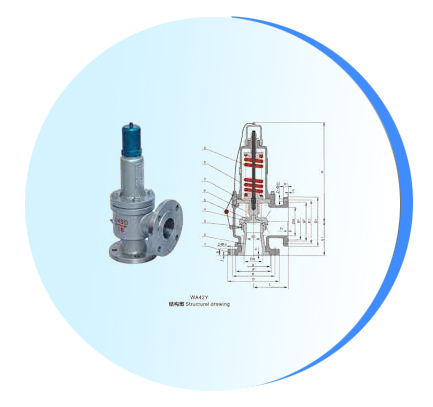
Pawar Industries is leading Manufacturers in Bellows Safety Relief Valves
Bellows Safety Relief Valves are crucial devices used in industries to protect equipment and systems from over pressure situations. These valves combine the reliable performance of safety relief valves with the added advantage of a bellows element, providing enhanced sealing and protection against corrosive or toxic media. In this comprehensive guide, we will delve into the working principles, benefits, applications, and maintenance considerations of Bellows Safety Relief Valves. Whether you are an engineer, safety professional, or someone seeking knowledge about pressure relief systems, this article will provide valuable insights into this essential component.
Working Principles of Bellows Safety Relief Valves (200 words).
Bellows Safety Relief Valves operate based on the principles of spring-loaded pressure relief. They consist of a valve body, seat, disc, spring, and a bellows assembly. The bellows, typically made of stainless steel, acts as a flexible sealing element that isolates the process fluid from the valve internals.
Under normal operating conditions, the system pressure is below the set pressure of the valve. The spring exerts a downward force on the disc, keeping it tightly seated against the valve seat. However, when the system pressure exceeds the set pressure, the force exerted on the bellows overcomes the spring tension, causing the bellows to expand. As the bellows expands, it lifts the disc off the seat, allowing the excess pressure to be safely relieved.
The bellows element provides several advantages over conventional safety relief valves, such as improved sealing performance, resistance to corrosion, and protection against fugitive emissions. It also compensates for temperature variations and prevents the process fluid from coming into contact with the valve's internal components, making it suitable for a wide range of applications.
Benefits of Bellows Safety Relief Valves -
Bellows Safety Relief Valves offer numerous benefits, making them an ideal choice for critical pressure relief applications. Here are some key advantages:
a) Enhanced sealing performance : The bellows element provides superior sealing capabilities, preventing leaks and ensuring a tight seal even in corrosive or toxic media. This feature is particularly valuable in industries where environmental protection and safety are paramount.
b) Corrosion resistance : The bellows assembly is constructed from materials such as stainless steel, which offers excellent resistance to corrosion. This makes Bellows Safety Relief Valves suitable for applications involving aggressive fluids or challenging environments.
c) Fugitive emissions control : The bellows element acts as a barrier, preventing fugitive emissions from escaping into the atmosphere. This is crucial in industries with stringent environmental regulations or when handling hazardous substances.
d) Temperature compensation : The bellows design allows for effective compensation of temperature variations. It accommodates thermal expansion and contraction, ensuring reliable performance in systems exposed to fluctuating temperatures.
e) High reliability and repeatability : Bellows Safety Relief Valves are known for their consistent performance and reliable operation. They undergo rigorous testing and adhere to strict quality standards, providing peace of mind in critical processes.
Applications of Bellows Safety Relief Valves -
Bellows Safety Relief Valves find applications in various industries where pressure safety and reliability are paramount. Some common areas of use include:
a) Petrochemical and chemical industries :
These valves are widely employed in refineries, chemical processing plants, and petrochemical facilities. They protect equipment such as pressure vessels, heat exchanges, and storage tanks from over pressure situations, ensuring safe and efficient operation.
b) Oil and gas production : Bellows Safety Relief Valves play a critical role in upstream and downstream operations within the oil and gas industry. They safeguard pipelines, compressors, and other equipment from excessive pressure, helping to prevent accidents and maintain operational integrity.
c) Pharmaceutical and biotechnology industries : In pharmaceutical manufacturing and biotechnology processes, maintaining pressure integrity is crucial. Bellows Safety Relief Valves are used to protect vessels, reactors, and other equipment from over pressure, ensuring product quality and operator safety.
d) Power generation : Power plants, including thermal, nuclear, and renewable energy facilities, rely on Bellows Safety Relief Valves to protect boilers, turbines, and other critical equipment. These valves help maintain safe operating conditions and prevent damage caused by excessive pressure.
e) Food and beverage industries : Bellows Safety Relief Valves are utilized in food processing, breweries, and beverage production facilities. They protect tanks, vessels, and processing equipment from pressure build-up, ensuring product quality and compliance with sanitary standards.
f) HVAC systems : Heating, ventilation, and air conditioning systems often incorporate Bellows Safety Relief Valves to safeguard against over pressure situations. These valves protect components such as chillers, boilers, and air handling units, ensuring safe and efficient operation.
Maintenance Considerations for Bellows Safety Relief Valves. -
Proper maintenance is essential to ensure the reliable performance of Bellows Safety Relief Valves. Here are some important considerations:
a) Regular inspection : Conduct periodic inspections to check for any signs of wear, corrosion, or damage to the valve body, bellows assembly, and other components. Promptly address any issues to maintain optimal performance.
b) Testing and calibration : Periodically test and calibrate the valves to ensure they are functioning within the desired pressure range. This helps maintain accuracy and reliability in pressure relief operations.
c) Environment monitoring : Monitor the process conditions, including temperature, pressure, and corrosive media, to assess the valve's operating environment. Take necessary precautions or consider specialized coatings or materials if the conditions are particularly challenging.
d) Maintenance records : Maintain detailed records of maintenance activities, including inspection dates, test results, repairs, and replacements. This documentation helps track the valve's performance history and aids in troubleshooting or future maintenance planning.
e) Manufacturer's guidelines : Follow the manufacturer's recommendations for maintenance procedures, lubrication, and spare parts replacement. Adhering to these guidelines ensures the valves operate optimally and remain compliant with industry standards.


